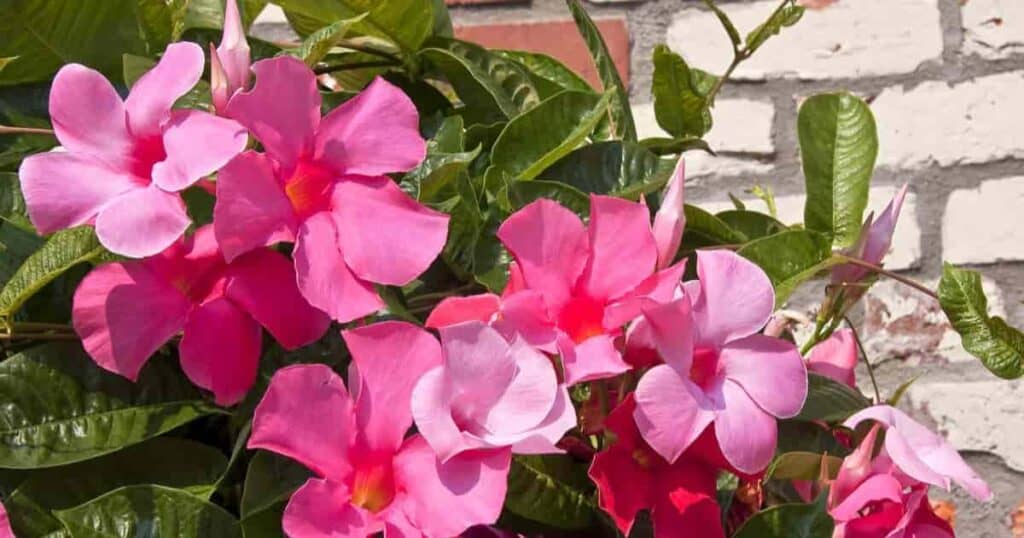Are Mandevilla plants poisonous to dogs? There is a lot of confusing information about whether Mandevilla plants are poisonous to dogs. Unfortunately, there isn’t a clear answer.
Mandevilla plants belong to the Apocynaceae plant family and are perennial climbers from Central, North, and South America. They have sweetly scented flowers.

Are Mandevilla Poisinous to Dogs?
Mandevilla is a large genus of about 200 species of flowering plants in the dogbane family, Apocynaceae. Other plants in this family include oleanders, plumeria, periwinkle, and blue star.
Although it is related to plants known to be toxic to animals and people, the American Society for the Prevention of Cruelty to Animals (A.S.P.C.A) does not consider it toxic to dogs.
With such wide varieties of Mandevilla, some may be toxic, while others are not. It’s hard to tell.
If possible, the best answer would be to keep dogs away from the plants. If your dog is not in the habit of eating your plants, then you probably don’t have anything to worry about.
The problem seems to be when the plant is consumed in large quantities or over an extended period.

The result is vomiting and diarrhea in dogs who eat large amounts of the plant regularly or in one sitting.
This is highly unlikely to happen as most dogs don’t often chew on plant leaves and dislike anything with a bitter taste.
If your dog eats some Mandevilla leaves but does not show any symptoms within 24 hours, then it’s unlikely that he ingested enough leaves to cause any problems with his digestive system or liver function.
However, if your dog shows any signs of illness after eating Mandevilla leaves, you should take him to your veterinarian as soon as possible.
Mandevilla vine plants are popular in gardens all over the world due to their unique color patterns and hardiness.
If you have a dog in the house, you may wonder if it is safe to grow Mandevilla with a dog. Read on to find out.
What Are Mandevilla Plants?
The Mandevilla plant is a flowering vine that produces small trumpet-shaped flowers that come in various colors, such as red, lavender, blue, and white.
These flowers are usually pink, but there are other varieties like white or blue.
Mandevilla was named after Henry Mandeville, a British diplomat and gardener who discovered the plant while visiting Argentina.
He brought it home to England in the 1800s. It may also be known as a “rock trumpet” or “diplodenia.”
These plants are easy to grow if you give them proper care and attention.
They can be planted in a container, taken outside during spring and summer, and then brought inside for winter.
They also make a wonderful addition to any garden or landscape because they attract butterflies and hummingbirds when they bloom.
Are They Annuals or Perennials?
Mandevilla is herbaceous perennials, but they can be grown as annuals in areas where winters are mild.
Mandevilla can reach heights of 10’ to 20’ feet or more when allowed to climb on poles or trellises.
They produce fragrant flowers that bloom from spring through fall and sometimes into winter under ideal conditions.
Planting Mandevilla
Mandevilla plants need well-drained soil that retains moisture and nutrients but doesn’t get too wet.
Amend your soil with compost or other organic materials to help with drainage and nutrient retention.
If you’re planting your Mandevilla indoors, start your seeds 6 weeks before the last frost date for your area.
Plant seeds at least ¼” inch deep in pots filled with potting soil mixed with vermiculite or perlite to help improve drainage and aeration of the soil.
Keep the soil moist but not soggy while the seeds are germinating.
Misting your seedlings daily will help keep their roots moist and prevent them from wilting during this crucial growth stage.
Once seedlings have sprouted, they move into bright indirect sunlight where temperatures stay between 65° and 80° degrees Fahrenheit.
Mandevilla Container Gardening
Container Mandevillas are is great. This allows you to have a variety of plants in your home without taking up valuable space in the yard.

This is an excellent option for those who do not have much time for gardening but still want to enjoy the beauty of flowers in their yard or garden area.
It allows you to have beautiful flowers without spending too much time maintaining them.
Growing Mandevilla Outdoors
Mandevilla can also be planted directly in the ground.
They are often used as ground cover in warm climates or U.S. Department of Agriculture plant hardiness zones 10 to 12 because they have small leaves that don’t need much water or fertilizer to thrive.
The plant can grow 10′ feet high if left unpruned and will flower all year long when grown outdoors.
Mandevilla is a hearty plant best grown outdoors in full sun and well-drained soil.
They should be spaced about 3′ feet apart to ensure good air circulation. Plants should be pruned back after flowering to promote new growth and flower production.
Mandevillas are generally fairly trouble-free plants, although they can be affected by mildew, especially during rainy weather or when there is lots of humidity in the air.
This can usually be controlled by spraying with a fungicide containing sulfur or copper.
If you notice that your plant is wilting or has brown spots on its leaves, do not water it until you have treated it with a fungicide, as excess moisture may worsen the problem.
Hopefully, this post will be helpful to other pet owners who are worried about their pets eating Mandevilla leaves.
In general, you should be careful when gardening with any plants if animals can reach them, but Mandevillas don’t pose any substantial threat—and they make your garden look beautiful.
